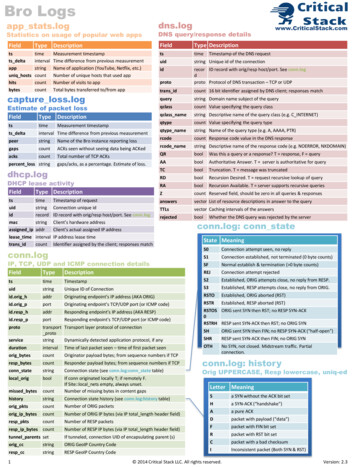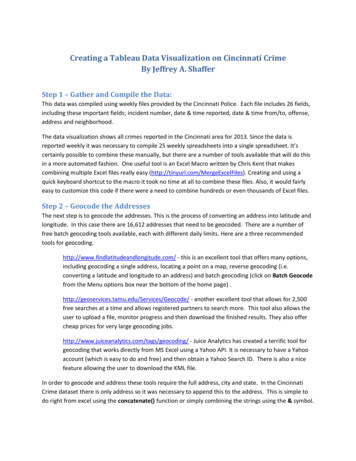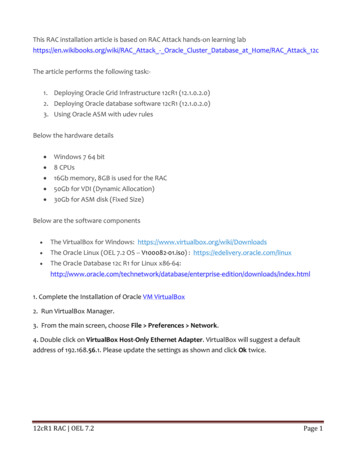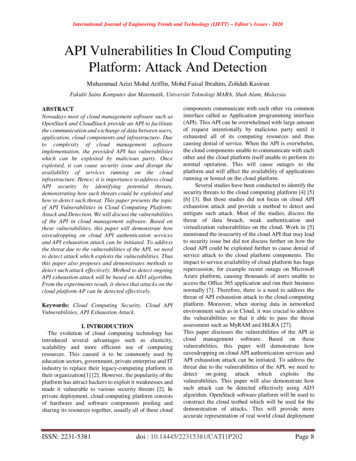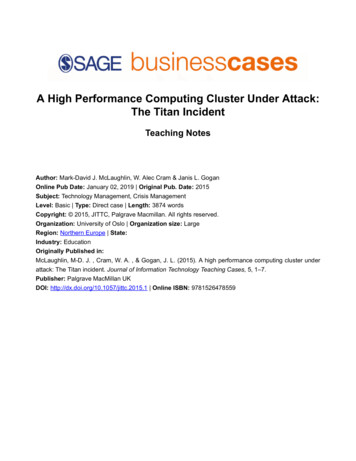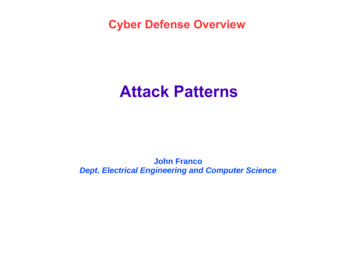
Transcription
Cyber Defense OverviewAttack PatternsJohn FrancoDept. Electrical Engineering and Computer Science
Attack PatternsWhat:An abstraction mechanism for describing how a type ofobserved attack is executed.Provides a description of the context where it is applicableand gives recommended methods of mitigating the attack.A blueprint to control an exploit: minimize damage, preserveevidence, provide quick and efficient recovery, prevent similarfuture events, and gain insight into threats against theorganizationWhy:To be effective in preventing and dealing with attacks, thecommunity needs to have a firm grasp of the attacker’sperspective and the approaches used to exploit softwareWe want to build security into the systems we develop andnot 'add' security after the system is wledge/attack-patterns/attack-pattern-usage
Attack PatternsAttributes:Pattern Name and Classification:A unique, descriptive identifier for the pattern.Attack Prerequisites:What conditions must exist or what functionality and whatcharacteristics must the target software have, or whatbehavior must it exhibit, for this attack to succeed?Description:A description of the attack including the chain of actions takenRelated Vulnerabilities or Weaknesses:What specific vulnerabilities or weaknesses does this attackleverage?Specific vulnerabilities reference industry-standard identifiers(CVE number, US-CERT number, etc.)Underlying issues that may cause vulnerabilities (weaknesses)also reference industry-standard identifiers (CWE number)
Attack PatternsAttributes:Method of Attack:What is the vector of attack used (e.g., malicious data entry,maliciously crafted file, protocol corruption)?Attack Motivation-Consequences:What is the attacker trying to achieve by using this attack?This is not the end goal of the attack within the target contextbut rather the specific technical result desired that could beleveraged to achieve the end mission objective.This information is useful for aligning attack patterns to threatmodels and for determining which attack patterns from thebroader set available are relevant for a given context.Attacker Skill or Knowledge Required:What level of skill or specific knowledge must the attackerhave to execute such an attack?Use rough scale (e.g., low, moderate, high)State contextual detail of what type of skills or knowledgeare required.
Attack PatternsAttributes:Resources Required:What resources (e.g., CPU cycles, IP addresses, tools, time)are required to execute the attack?Solutions and Mitigations:What actions or approaches are recommended to mitigate thisattack, either through resistance or through resiliency?Context Description:In what technical contexts (e.g., platform, OS, language,architectural paradigm) is this pattern relevant?This information is useful for selecting a set of attack patternsthat are appropriate for a given context.References:What further sources of information are available todescribe this attack?Common Attack Pattern Enumeration & Classification: https://capec.mitre.org/
Attack PatternsExample 1: Exploiting Software, G. Hoglund, G. McGraw, 2004Name and classification:Make the client invisible.Attack Prerequisites:The application must have a multi-tiered architecture with adivision between client and server.Description:This attack pattern exploits client-side trust issues that areapparent in the software architecture. The attacker removesthe client from the communication loop by communicatingdirectly with the server. This could be done by bypassing theclient or by creating a malicious impersonation of the 301Man-in-the-Middle (MITM)Origin Validation ErrorAuthentication Bypass by SpoofingMissing Authentication for Critical FunctionReflection Attack in an Authentication Protocol
Attack PatternsExample 1:Method of Attack:Direct protocol communication with the serverAttack Motivation and Consequences:Potential information leak, data modification, arbitrary codeexecution, etc. These can all be achieved by bypassingauthentication and filtering, accomplished with this attackpattern. The application must have a multi-tiered architecturewith a division between client and server.Resources Required:None, although protocol analysis tools and client impersonationtools such as netcat can greatly increase the ease andeffectiveness of the attack.
Attack PatternsExample 1:Solutions and Mitigations:Increase Resistance to Attack:Utilize strong two-way authentication for all communicationbetween client and server. This option could have significantperformance implications.Increase Resilience to Attack:Minimize the amount of logic and filtering present on client;place it instead on the server.Use white lists on server to filter and validate client input.Context Description:Any raw data that exist outside the server software cannot andshould not be trusted. Assume all clients will be hacked. Thereal problem is client-side trust. Accepting anything blindly fromthe client and trusting it is a bad idea, and yet this is often thecase in server-side designReferences:Exploiting Software, G. Hoglund & G. McGraw, Addison Wesley
Attack PatternsExample 2: Exploiting Software, G. Hoglund, G. McGraw, 2004Name and classification:Shell Command Injection—Command DelimitersAttack Prerequisites:The application must pass user input directly into a shellCommand.See xss.java example
Attack PatternsExample 2:Description:Using the semicolon or other off-nominal characters, multiplecommands can be strung together. Unsuspecting targetprograms will execute all the commands. An example authenticating a user using a web form where the username ispassed directly to the shell as in:exec("cat data log " userInput ".dat")the " " sign denotes concatenation. The developer expectsthat the user will only provide a username. But, a malicioususer could supply "username.dat; rm –rf / ;" as the inputto execute the malicious commands on the machine runningthe target software. Similar techniques are used in otherattacks such as SQL injection. Command executed above iscat data log username.dat; rm –rf /; .datThe 'cat' may or may not succeed; the 'rm' will delete everythingon the file system to which the application has access, andwhat happens with '.dat' is likely not relevant.
Attack PatternsExample 2:Related Vulnerabilities and Weaknesses:CWE-77/78OS Command InjectionCVE-1999-0043 Command execution via shell metacharsCVE-1999-0067 phf CGI allows shell execution via metacharsCVE-1999-0097 FTP client shell execution via metacharsCVE-1999-0152 Finger daemon allows shell execution via metcharsCVE-1999-0210 Privilege escalation via automountd & metacharsCVE-1999-0260 jj CGI prog allows shell execution via metacharsCVE-1999-0262 Linux CGI script remote execution of anythingCVE-1999-0279 EWS allows shell execution via metacharsCVE-1999-0365 Metamail allows shell execution via metacharsMethod of Attack:By injecting other shell commands into other data that arepassed directly into a shell command.Attack Motivation-Consequences:Execution of arbitrary code. Attacker uses target software withelevated privilege to execute otherwise protected commands
Attack PatternsExample 2:Attacker Skill or Knowledge Required:Finding and exploiting this vulnerability does not requiremuch skill. A novice with some knowledge of shellcommands and delimiters can perform a very destructiveattack. A skilled attacker, however, may be required to subvertsimple countermeasures such as rudimentary input filtering.Resources Required:No special or extensive resources are required for this attack.Solutions and Mitigations:Define valid inputs to all fields and ensure that the user inputis always valid. Also perform white-list and/or black-listfiltering as a backup to filter out known command delimiters.Context Description:OS: UNIX.References:Exploiting Software, G. Hoglund, G. McGraw, Addison-Wesley, 2004
Attack PatternsAlso For Fun:Attack Pattern ledge/attack-patterns/attack-pattern-glossary
Attack PatternsAttack Pattern Usage:Attack Patterns can be leveraged for the production of safe codeDuring all phases of the Software Development Life CycleFunctional Requirements:Include high-level requirements such as“users will be able to access the site using at least the latestversions of Chrome, Edge, and Mozilla Firefox” and“users shall be able to purchase books in any currency”.Generally lead to more detailed functional requirements andcan potentially drive out security requirements.These security requirements can be functional or not functionalin nature, but equally important.Detailed functional and non-functional requirements includingsecurity requirements are often overlooked and neglectedbecause the general focus is basic functionality.Ex: next page
Attack PatternsAttack Pattern Usage:Derive Security Requirements from Functional Requirements:Operational questions arise naturally from the functional specs1. If user views website with browser other than latest versionof Chrome, Edge, or Firefox, what should happen?2. Is it acceptable if the browser crashes?3. Is it acceptable if absolutely nothing is displayed?4. Is there anything that the server needs to do to differentiatebetween browsers?5. What happens if the self-identification data sent by client isspoofed (e.g., if Firefox is set to report itself as Opera)?6. If users can purchase books in other currencies, then shouldthey be able to browse the website in other languages orencoding schemes?7. If so, how many languages and encoding schemes shouldthe website support?8. What should happen if a client sends characters from alanguage or encoding scheme that the server doesn't accept?
Attack PatternsAttack Pattern Usage:Derive Security Requirements from Functional Requirements:Process of making functional requirements more specific isan effective mechanism for identifying security requirements.Consider question 8.Person writing functional spec may respond with:If a client sends characters from a language that theserver does not recognize, then the server will return aHTTP 415 status codewhich is now a security (well, safety) requirement.This informs the developers how to handle the issue raisedby question 8.Otherwise, the problem might be overlooked, causing issuessuch as attackers being able to bypass input filters.
Attack PatternsAttack Pattern Usage:The Role of Attack Patterns in Deriving SR from FR:The functional specifications contain keywords that may matchdeveloped attack patterns.Example: customer says “the application must acceptASCII characters.” This triggers looking at the “UnicodeEncoding” attack patternhttps://www.owasp.org/index.php/Unicode EncodingThis raises the question:What should the application do if Unicode characters or otherunacceptable character set is encountered?From this question, misuse/abuse cases can be defined such asmalicious user provides Unicode chars to the data entry fieldThis gives designers a clear understanding of the environmentthey are designing for: they will be aware of this when designingThis also infers a security requirement: the system will filter allinput for Unicode characters (could be overlooked otherwise)
Attack PatternsAttack Pattern Usage:The Role of Attack Patterns in Deriving SR from FR:Many vulnerabilities are due to vague specs and requirements.This includes "unspecified behavior" in certain specifications(e.g., C language and how compilers must deal with certainsituations or RFCs such as IP fragmentation and how endnodes interpret the specification in varying fashions).Requirements should specifically address these ambiguitiesto avoid opening up multiple security holes.Attack patterns allow the requirements gatherer to ask'what if' questions to make the requirements more specific.If an attack pattern statesCondition X can be leveraged by an attacker to cause Ythen a valid question may beWhat should the application do if it encounters condition X?
Attack PatternsAttack Pattern Usage:Architecture and Design:Decisions must be made regardinghow software is to be structuredhow the various components will integrate and interactwhich technologies will be leveragedhow requirements defining software function will be interpretedNote: 50% of mistakes leading to security flaws are from design
Attack PatternsAttack Pattern Usage:Architecture and Design:Consider 3-tier architecture:Client: web browser leveraging javascript and htmlWebServer: leveraging java servletsDatabase server: leveraging Oracle 10iSome Attack Patterns describe attacks exploiting arch flawsEx: Make the Client Invisible exploits client-side trust issuesAccording to this Attack Pattern:Nothing sent back by the client can be trusted even under SSLAn attacker can spoof a client and send back anythingAll input validation, authorization checks, etc. must thereforebe performed on the server side.Data that the client should not see should never be sent to itPerforming authorization checks on the client side to determinewhat data to display is unacceptable.
Attack PatternsAttack Pattern Usage:Implementation and Coding:In theory, each developer implementing the design should bewriting well-defined components with well-defined interfacesat this pointAttack Patterns allow developers to ensure that knownweaknesses do not creep into the code they writeBut the relevant Attack Patterns must be foundArray Out of Bounds attack pattern not relevant for JavaConsider: leveraging an attack pattern such asSimple Script Injection to avoid XSS vulnerabilities.Method: identify all places from which output is being sent to theuser from an untrusted source and convert potentially dangerouscharacters into their HTML equivalents (e.g. <)Malicious data could include artifacts such as script tagsinserted by an attacker (see example)
Attack PatternsSoftware Testing and Quality Assurance:Goal: attempt to break software so that the discovered issuescan be fixed before an attacker can find them.Purpose of attack patterns: have testers act as attackersUnit Testing:Test components independently to ensure they meet specsAttack Patterns identify relevant targeted weaknesses andsupport test case generation for each componentExample: to test for shell command injection using commanddelimiters, malicious input strings containing delimiterseparated shell commands can be crafted and input to therelevant components to ensure proper behavior.
Attack PatternsSoftware Testing and Quality Assurance:Integration Testing:Test components together to ensure interfaces match andfunctionality does not conflictSecurity issue: do different components make differentassumptions regarding security that cause ambiguity orconflict?Example: the Make the Client Invisible attack pattern can beused to create test cases that simulate an attacker bypassingthe client and communicating directly with the server or anattacker impersonating the client to send malicious data tothe server
Attack PatternsSoftware Testing and Quality Assurance:System Testing:Test entire system to ensure system specs are satisfiedAttack Patterns: test the attack patterns used in requirementsgathering phase.Example: the Unicode Encoding attack pattern can be used togenerate test cases that ensure that the system behavesproperly when provided with unexpected characters.Testers provide characters that the application is not supposedto accept to the application to see how it behaves. Theapplication’s actual behavior when under attack should becompared with the desired behavior defined in the securityrequirements.
Attack PatternsSoftware Testing and Quality Assurance:Regression Testing:Run tests when code is changed to make sure there is no(or unauthorized) change in behaviorAttack Patterns: same as above – nothing new here
Attack PatternsSoftware Testing and Quality Assurance:Testing in the Operational Environment:For software to be useful it must be accessible – that meansthe bad guys have a chance at using it too, especially in anoperational environment that is insecure (e.g. foreign spieshave been employed at the NSA – they started out as goodguys – U.S. citizens but they were recruited through money)Software can be designed to be rock-solid secure but theoperators, even well-intentioned, may cause 1998/07/sunk-by-windows-nt/Attack Patterns: penetration testing based on identifiedattack patterns – find implementation security failuresWhite box testing (everything is known about the system)against security requirements developed above – uncoverunexpected architecture/design and implementation issues
Attack PatternsSoftware Testing and Quality Assurance:Testing in the Operational iane-5-launcher-failure?next slideshow 1
Attack PatternsSoftware Testing and Quality Assurance:Black Box Testing (penetration testing):Black-box testing tools cannot determine the meaning of data(e.g. whether it is a social security number) and cannot applybusiness logic.Attack patterns: those that can be executed remotely withoutrequiring many steps.Examples: cross-site scripting using injection of JavaScript ina HTTP parameter and SQL injection using separatorcharacters.Automated tools can be used to create tests, such as wherea separator character is inserted into a HTML form field, toobserve whether a database error occurs.
Attack PatternsSoftware Testing and Quality Assurance:White Box Testing:Extensive analysis performed by security experts that haveaccess to the software’s requirements, architecture, design,and code. Should get better results from white box testing.Testing may span months!Attack patterns: determine areas of system risk henceareas of the system the white-box analysis should focus.Attack patterns most effective: those that target architectureand design weaknesses.Attack patterns useful for finding implementation weaknessesare used because weaknesses are found using code reviewsExample: Sniffing Sensitive Data on an Insecure Channel.Allows to determine if some information that should always becommunicated over an encrypted channel is sent over aninsecure channel. Since this issue is specific to a deployedenvironment, analysis of the deployed software is required
Attack PatternsSoftware Testing and Quality Assurance:System Operation:Attack patterns: can guide design of secure operationalconfigurations and procedures.operational knowledge of security issues observed in thedeployed system can be used to feed back into the attackpattern generation processImproved operational procedures for security in the field maybe found using attack patterns that emulate what an attackermight try.In case of a successful exploit, investigation may result innew attack patterns that can be used to change configurationsor operating procedures and be applied to redesign toprevent this type of attack being successful in the future
Attack PatternsSoftware Testing and Quality Assurance:System Operation:Needed Because: a large part of environmental conditionsconsist of operational configurations and procedures.Vulnerable code exists in the field: maybe the vulnerabilities are known but cost too much to fix may cost less to mitigate attacks in the field instead ofpreventing problems in design
CWE-301 Reflection Attack in an Authentication Protocol Attack Patterns. Example 1: . the client and trusting it is a bad idea, and yet this is often the case in server-side design References: . CVE-1999-0097
